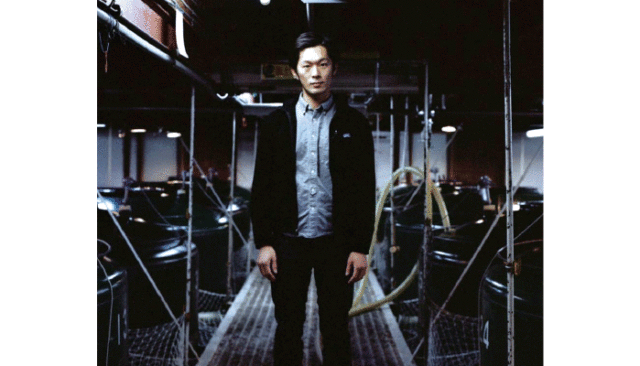The future of Japanese sake – A Young Sake Brewer at Miyasaka Brewing Company, Ltd. Shares His Vision
Miyasaka Brewing Company Ltd. has been brewing sake in Suwa in the mountainous region of Nagano Prefecture for more than 350 years. Its main brand, Masumi, has been making inroads in the US. The heir to this long-established brewery is Katsuhiko Miyasaka. He spoke passionately to us about the outlook for sake.
There are more than 1,400 sake breweries in Japan. Among them, Miyasaka Brewing has a relatively long history. The family can be traced back to a local samurai clan. They started in the sake business in 1662. “We have been making offerings to the local shrine, Suwa Taisha, ever since,” says Miyasaka. “The name Masumi comes from a treasure handed down through the generations at the shrine known as Masumi’s Mirror.”
The name fits the sake, which has clarity and depth. This is made possible because Miyasaka Brewing has access to the Suwa area’s highest-quality water. A very important element for the brewery is its yeast, the “No.7,” which is part of its history and helps define the taste of its sake. “Japanese sake is made from rice, water, and yeast. In Japan, the yeast is numbered in the order they are discovered, No.1, No. 2 and so on. The one that we discovered about 70 years ago was No. 7. Today, there are as many as 19, but No. 7 is the most widely used in Japan,” Miyasaka says.
According to Miyasaka, the type of water one uses for their sake defines the “character” of the sake. Hard water with higher mineral content produces a macho, solid sake. Soft water with less mineral content produces a feminine, soft sake. The type of rice defines the “body” of the sake. And the type of yeast defines the “fashion” of the sake. “For example, use No. 18, and you’ll get a very gorgeous aroma. It’s like a dress with lamé. Compare that with No. 7, which is a yeast for everyday wear – a white shirt, denim slacks, casual attire,” Miyasaka explains. Depending on how you dress, he continues, a simple white shirt can be just a cheap shirt or something of high-quality tailoring. “I see the attraction in No. 7 because while it can be enjoyed every day, it also has the characteristics to make something of quality depending on your effort.”
After graduating from university, he worked at one of the largest department stores in Japan, worked as a sake wholesaler in London, then returned to the family brewery in 2013. “Upon my return, even though our brewery was the originator of No. 7, we used the yeast in just 40% of our Masumi line. For higher value products, we used the floral No. 18 and others. But I felt that we should be using No. 7. It’s not flashy, but simple and mellow. No matter the existing ideas and methods, I wanted to try a new approach,” Miyasaka says. Today, the brewery’s usage rate for No. 7 is around 80%.
“Until fairly recently, the thinking in the sake industry was to make as efficiently as possible the product that sold the most,” he says. “The sake breweries became plain and lacking character. Without diversity, it is hard to maintain and increase sake enthusiasts. In this current age, each brewer should understand each strength and focus on it going forward.” He explains that it’s not about making something that everyone likes but about making a brand that only they can create in the new era. Miyasaka Brewing is thoroughly focused on using No. 7 yeast and returning to its roots.
Tips to enjoy sake-pairing in Seattle
These days pairing is not just for wine. The latest trend pairs all sorts of drinks with food. We asked Miyasaka to give us the basics on this latest trend as it relates to sake.
Check where the brewery is located Sake made in areas far from the ocean are brewed with the idea of matching meat and vegetables. Breweries closer to the water are better paired with seafood. If you’re pairing with some of Seattle’s seafood, make sure to find a brewery that is near the ocean. Seattle is also rich in mushrooms and other mountain offerings. When eating those types of foods, find a brewery near the mountains, and whether you are eating Japanese cuisine or American cuisine, it should go well with your dishes.
Check the milling rate Names like “daiginjo” and “junmai ginjo” are decided based on the rice milling rate. The more the rice is milled, the more the outer unfavorable-tasting part is taken out, leaving a crisp, elegant taste. Subtle flavors such as fresh cheese or white fish pair well with very well-milled, polished crisp and light sake. Rich meat dishes go best with rich-tasting sake that isn’t as milled.
Namazake and fresh seafood pairings in spring Namazake that comes out in spring is unpasteurized, so it contains a lot of sweetness. It goes perfectly with Seattle’s freshly caught oysters. It also goes well with sashimi-style salmon dishes like carpaccio. The sakes that go with salmon change depending on whether the fish is served raw, lightly grilled, grilled and seasoned with salt, cooked with lemon and herbs or with butter. Find the right pairings for your favorite salmon dishes.
Miyasaka Brewing Company, Ltd.
☎︎ 81-266-52-6161
www.masumi.co.jp




